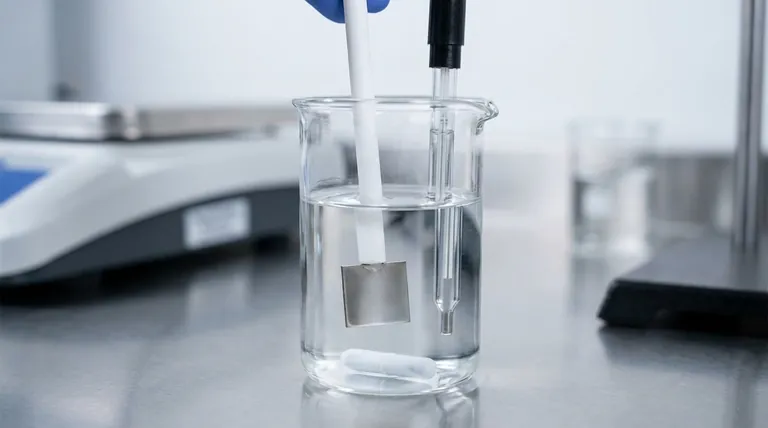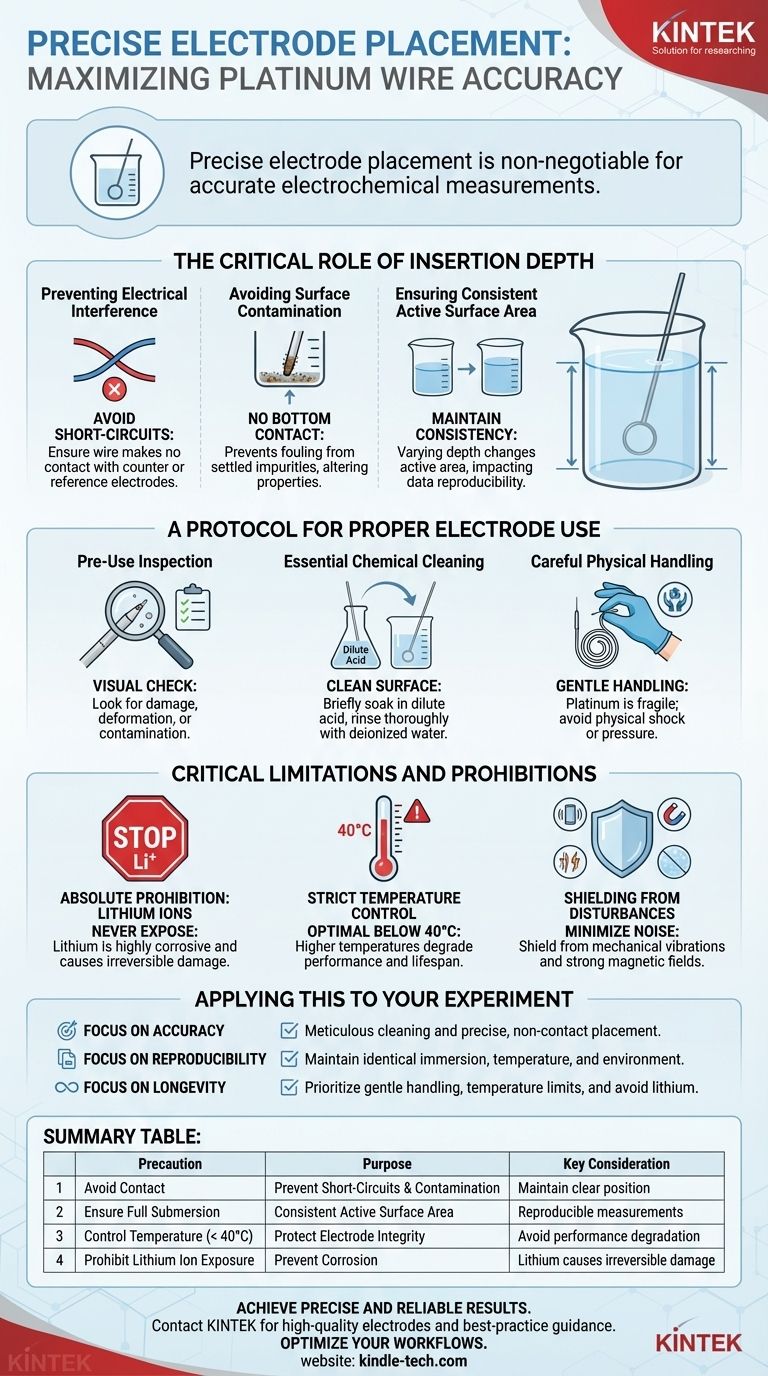Precise electrode placement is a non-negotiable step for accurate electrochemical measurements. Regarding insertion depth, the primary precaution is to ensure the platinum wire is fully submerged in the electrolyte but makes no physical contact with the bottom of the container or any other electrodes. This prevents electrical short-circuits and contamination, which would invalidate your results.
Proper use of a platinum wire electrode goes far beyond insertion depth. Achieving reliable and reproducible data requires a systematic approach that encompasses meticulous cleaning, careful handling, and strict control of the experimental environment.

The Critical Role of Insertion Depth
The depth at which you place your electrode is not arbitrary. It directly influences the integrity and quality of your electrochemical data.
Preventing Electrical Interference
You must position the platinum wire so it does not touch the counter or reference electrodes. Direct contact creates a short-circuit, immediately corrupting your potential and current readings and rendering the measurement useless.
Avoiding Surface Contamination
The bottom of your electrochemical cell often collects settled impurities from the electrolyte or previous experiments. Allowing the electrode to touch the bottom can foul the platinum surface, altering its catalytic properties and introducing significant experimental error.
Ensuring a Consistent Active Surface Area
For results to be reproducible between experiments, the active surface area of the electrode immersed in the electrolyte must be consistent. Varying the immersion depth changes this area, which directly impacts measured current density and can make comparing different data sets impossible.
A Protocol for Proper Electrode Use
Successful measurements begin long before the electrode enters the electrolyte. A disciplined approach to preparation and handling is essential for protecting this sensitive instrument.
Pre-Use Inspection
Before every use, visually inspect the electrode. Look for any signs of damage, deformation, or visible contamination. Scratches or stains on the platinum surface can create active sites that alter electrochemical behavior and must be addressed.
Essential Chemical Cleaning
To remove surface oxides and organic impurities, you must clean the electrode before use. A standard procedure is to briefly soak the platinum wire in a dilute acid, such as dilute nitric acid, followed by a thorough rinse with deionized water. This restores a clean, active platinum surface.
Careful Physical Handling
A platinum wire electrode is delicate and fragile. The soft metal can be easily bent or damaged by physical shock or pressure. Always handle it gently to maintain its structural integrity.
Critical Limitations and Prohibitions
To ensure both data accuracy and the longevity of your electrode, you must be aware of its operational limits and absolute restrictions.
The Absolute Prohibition: Lithium Ions
Never allow the electrode to come into contact with lithium ions. Lithium is highly corrosive to platinum and will cause irreversible damage to the electrode. Its use is strictly prohibited.
Strict Temperature Control
While platinum has high-temperature resistance, for electrochemical applications, it is strongly recommended to operate at lower temperatures, ideally below 40°C. Higher temperatures can negatively affect the electrode's performance, stability, and lifespan.
Shielding from External Disturbances
The electrochemical system is sensitive. To maintain a stable measurement environment, you must shield your setup from external mechanical vibrations and strong magnetic fields, as these can introduce noise into your data.
Applying This to Your Experiment
Use this checklist to guide your actions based on your primary experimental goal.
- If your primary focus is accuracy: Meticulously follow the chemical cleaning protocol before each run and ensure the electrode is positioned to avoid all physical contact within the cell.
- If your primary focus is reproducibility: Maintain an identical immersion depth, temperature, and shielded environment across all comparative experiments.
- If your primary focus is electrode longevity: Prioritize gentle handling, strictly adhere to the temperature limits, and absolutely avoid any exposure to lithium ions.
Mastering these fundamental precautions transforms your electrode from a simple tool into a reliable instrument for generating trustworthy data.
Summary Table:
| Precaution | Purpose | Key Consideration |
|---|---|---|
| Avoid Contact with Cell Bottom/Other Electrodes | Prevent Short-Circuits & Contamination | Maintain a clear, isolated position in the electrolyte |
| Ensure Full Submersion | Consistent Active Surface Area | Reproducible current density and measurements |
| Control Temperature (< 40°C) | Protect Electrode Integrity | Avoid performance degradation and damage |
| Prohibit Lithium Ion Exposure | Prevent Corrosion | Lithium ions cause irreversible platinum damage |
Achieve precise and reliable electrochemical results with confidence. Proper electrode handling is fundamental to your lab's success. At KINTEK, we specialize in high-quality lab equipment and consumables, including durable electrodes designed for accuracy and longevity. Let our experts help you select the right tools and provide best-practice guidance for your specific applications. Contact us today to optimize your electrochemical workflows and enhance your data quality!
Visual Guide

Related Products
- Platinum Sheet Electrode for Laboratory and Industrial Applications
- Platinum Auxiliary Electrode for Laboratory Use
- Rotating Platinum Disk Electrode for Electrochemical Applications
- Reference Electrode Calomel Silver Chloride Mercury Sulfate for Laboratory Use
- Gold Disc Electrode
People Also Ask
- What are the performance characteristics of platinum sheet electrodes? Unlock Superior Electrochemical Performance
- What is the expected lifespan of a platinum sheet electrode? Maximize Your Electrode's Service Life
- What are the key performance characteristics and applications of platinum sheets? Unmatched Reliability for Demanding Applications
- What is the proper post-treatment procedure for a platinum sheet electrode? Ensure Long-Term Accuracy & Protect Your Investment
- What are the available specifications for platinum sheet electrodes? Find the Perfect Fit for Your Electrochemical Needs



















